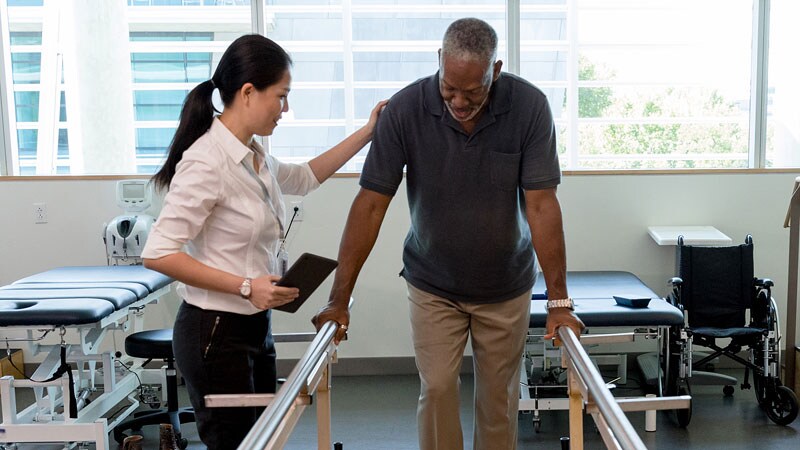A new technology that maps the wiring of the brain can predict the course of recovery in patients who have suffered stroke, enabling a more individualized approach to rehabilitation therapy.
The technology uses “connectomes” that are generated by analyzing multiple images taken from MRI and form a “blueprint” of how a brain’s neurons connect to each other.
New research analyzing connectomes with the help of machine learning accurately predicts the recovery potential of patients who have suffered a recent stroke.
“This is a very exciting advance. We are astonished that the predictive values were so good,” senior study author Friedhelm Hummel, MD, told Medscape Medical News. “It is a major advantage to be able to look at the whole brain,” he added.
The study was published online July 8 in the journal Brain.
A Whole Brain Approach
Hummel, who is chair of clinical neuroengineering at the Swiss Federal Institute of Technology, Lausanne, Switzerland, said this new technology should help to optimize and personalize rehabilitation treatment strategies in stroke care.
“The acute treatment of stroke is clear, but then comes the whole rehabilitation process which can go on for many months, years, or indeed the rest of a patient’s life,” he noted.
Around two thirds of patients show a natural recovery and regain about 70% of the deficit after stroke, whereas around one third do not achieve such a natural recovery, Hummel explained.
“It is difficult to predict in the early days and weeks after a stroke which patients are going to make a natural recovery and which ones aren’t. This is particularly hard in patients who are very severely impaired immediately after the stroke.”

Dr Friedhelm Hummel
He pointed out that the brain works like a network. “If a stroke happens it affects not only the one area where it occurred but there is also a ‘network effect.’ If we take this into account, we have a better picture of what is happening in the brain. We are not just looking a one part of the brain, but the whole brain network. We wanted to know if this gives us more information on patient recovery.”
Connectomics is a new area analyzing both functional and structural connections in the brain. For this study, the researchers focused on structural connections.
The investigators analyzed connectomes from 92 patients 2 weeks after stroke, tracking connectome changes up to 3 months later while also assessing motor impairment using the Fugl-Meyer Upper Extremity (FMUE) scale.
Personalized Recovery
The connectome information was analyzed by a machine-learning model known as a “support-vector machine”, which was programmed to distinguish between patients who make a natural recovery from those who don’t achieve a natural recovery based on their whole-brain structural connectomes.
Prediction accuracies were cross-validated internally in one independent dataset and generalized in two independent datasets.
Results showed that the structural connectomes at 2 weeks were a good predictor of motor recovery at 3 months.
Among the whole group, the technology showed an accuracy of 0.92 and a precision of 0.93 in predicting patients who would have natural recovery, with similar results for those with severe stroke deficits.
“Severely impaired patients are incredibly variable when it comes to natural recovery so to have this degree of predictive ability is amazing,” Hummel commented.
“In one of the validation cohorts the predictive value was 1.0, that is 100%, but we have to acknowledge the caveat that this was a small group,” he added.
To be able to predict individual courses of recovery early on will have an important impact on clinical management, translational research, and treatment choice, Hummel said.
“If we know there’s not going to be so much natural recovery we need to target these patients for more intensive and longer-term rehabilitation therapy. If we know there’s going to be a good natural recovery, then these patients may receive a different approach to rehabilitation. This technology will allow a personalization of treatment,” he added.
Not Ready for Prime Time
The technology is not yet ready for clinical use. It needs to be further validated in different datasets and a methodology needs to be developed to enable an automated version for use in the clinic.
“This technology can be used with a standard 3 Tesla MRI, but we need to develop a program that everyone can use that does the analysis for you. That is one of the next steps,” Hummel said.
He believes the connectome technology will first be used in clinical research to help stratify patients in clinical trials, and this could start to happen now.
“If we know a patient is likely to make a good natural recovery that needs to be taken into account when evaluating a potential new intervention. If we see an improvement with an intervention in a patient who we know was unlikely to make a good natural recovery, then we know for sure that the intervention is working,” he notes.
Potential for it can also be used to select a homogeneous group of patients — those with either a high or low likelihood of a good natural recovery, so certain therapies could be targeted at certain patients.
It is thought that the connectome technology will therefore make clinical trial results easier to interpret and may lead to fewer patients being required for certain trials.
“If we understand the heterogeneity of the group at the start then we can better understand the results,” Hummel explained. “If the whole group shows a 70% improvement with a certain intervention from baseline and we have only included patients who show a good natural improvement, then the intervention isn’t doing very much. But if patients have no natural recovery then any improvement with an intervention is impressive.”
The researchers also suggest that using whole-brain connectomes has the potential to identify neuronal networks underlying the recovery process and therefore provides valuable information toward individualized targets for new therapeutic strategies.
This work was partially supported by the Defitech Foundation, the Wyss Foundation, the Bertarelli Foundation, and the National Research Foundation of Korea. The authors have disclosed no relevant financial relationships.
Brain. Published online July 8, 2021. Full text
For more Medscape Neurology news, join us on Facebook and Twitter

